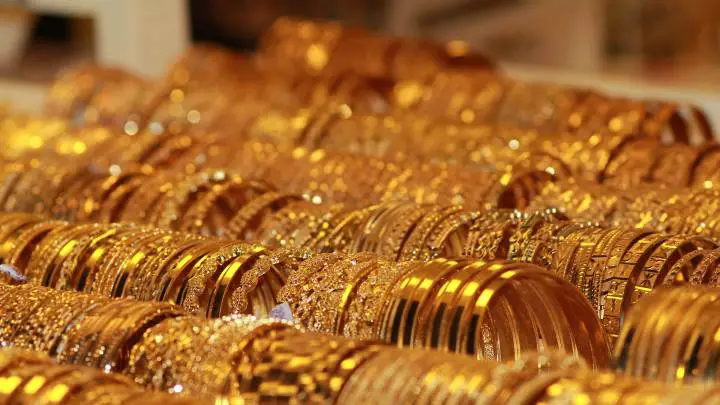Gold is one of the most common precious metals in the world. It’s so highly sought after that it has become one of the world’s most valuable resources due to its scarcity and durability. One question that has been bothering many people is ‘Is gold plated real gold?’
The short answer is no. Gold plated is not real gold; it simply has a thin layer of real gold covering the surface.
So what is gold plating? How can you differentiate gold plated from solid gold? What are the best ways to make sure your gold-plated items last you a long time? Find out in this article.
What Is Gold Plating?
Gold plating is the process of using electricity and chemicals to deposit a thin layer of gold over another metal (usually copper or silver). The depth of this layer varies from manufacturer to manufacturer and depends on the manufacturer’s quality standards.
There are three essential ingredients to gold plating. The first is the metal you want to plate, which is gold. Next is the metal you want to use as the base substrate. And finally, the chemical solution helps transfer the gold to the base metal.
The gold plating process involves dipping the base metal into an electrolyte solution that contains dissolved gold ions and then applying electricity to it so that the gold ions in the electrolyte solution adhere to the base metal.
Gold plating is not permanent because the thin layer of gold on top of the base metal can wear away due to regular wear and tear. Even if you take care of your jewelry by removing it before showering, eventually the gold layer will fade and tarnish.
SEE: How to Clean Gold Plated Jewelry (Without Ruining It)
Is Gold Plated Real Gold?
The answer is no, gold plated is not real gold. It’s a coating of real gold on top of another metal (usually silver or copper).
This type of jewelry may look like the real thing, but it’s just a thin layer of gold over silver or another base metal. That means it’s much cheaper than gold-filled and solid gold jewelry.
The only drawback to the gold plating on jewelry is that it doesn’t last as long as solid gold. It won’t last more than two or three years if you wear it every day.
Solid Gold and Gold Plated Jewelry: What’s the Difference?
Solid gold jewelry refers to any type of jewelry that’s made entirely from gold. It may be 14-karat, 18-karat, or 24-karat gold, depending on the manufacturer and price. The higher the karat, the purer the gold is in the piece of jewelry.
On the other hand, gold-plated jewelry has a layer of gold on it, but the base metal underneath is not gold. The base metal is usually copper or silver, though manufacturers use other metals like nickel and zinc.
Another major difference between solid gold and gold-plated jewelry is the price. Solid gold jewelry is significantly more expensive than gold-plated. This is because solid gold is of higher quality and a lot rarer than gold-plated jewelry.
If you’re looking for a piece of inexpensive jewelry to wear for just one occasion, then gold-plated is a good choice. Because of its low cost, you can enjoy a luxurious-looking piece of jewelry without having to pay a fortune for it.
However, if you want to wear your jewelry every day without having to worry about it tarnishing, go for solid gold. It contains more gold, so it is more durable and will last longer than any type of jewelry.
SEE: How Long Does Gold-Plated Jewelry Last? Tips on How to Care For Your Jewelry
How Thick Should Gold Plating Be?
When it comes to gold plating and jewelry, the thicker the layer of gold, the more valuable it is. The layer is measured in microns, and the minimum thickness for a piece of jewelry is 0.5 microns.
This can last for a year or two if you take care of it properly. However, if you expose it to chemicals or if you rub it against another jagged object, then it can wear off faster.
You can test the thickness of gold plating by doing a scratch test where you try to scratch off the gold using a sharp object like a knife. If you can scratch off the gold, then your gold plating is not thick enough and you need to replace it.
If you can’t scratch off the gold, then the gold plating is thick enough and will last for a long time. Clean it with a soft cloth or a polishing cloth, and then store it in a box that prevents chemical reactions like tarnishing.
Can You Make Gold Plated Jewelry Last Longer?
Yes, you can. If you want your gold-plated jewelry to last as long as possible, there are some steps you can take. Here are some tips for caring for and storing your jewelry:
Wipe it with a polishing cloth
Polishing cloths are an easy, inexpensive way to keep your gold-plated jewelry looking its best. These are available at hardware stores, department stores, and craft stores.
All you need to do is wipe down your jewelry with the polishing cloth to remove any dirt or buildup on the surface of the gold plating.
Clean with soap and water
One of the best things you can do for your jewelry is to clean it gently with warm, soapy water. Be gentle when cleaning, because gold plating is thin, and harsh scrubbing can wear away at it.
Use toothpaste
A simple and effective method for cleaning gold-plated jewelry is to use toothpaste. Apply a small amount of toothpaste to a damp cloth, use it to buff your piece, rinse, and air-dry. Toothpaste contains mild abrasives, which help to scrub away tarnish.
Avoid harsh chemicals
Always remove your jewelry before using any kind of harsh chemicals, including things like hairspray, perfume, or sunscreen. The chemicals in these products can cause the gold plating to wear off more quickly.
Baking soda wash
Another simple way to clean gold-plated jewelry is with baking soda. Simply combine two tbsps of baking soda with one tbsp of water and stir until it forms a smooth paste.
Use your fingers or an old toothbrush to apply the paste to your piece and rub gently into crevices and indentations. Rinse clean under warm water and polish dry with a soft cloth.
Avoid chlorinated water
If you’re going swimming in a pool or hot tub, be sure to remove any gold-plated jewelry first. Chlorine can cause the gold plating to wear off faster than usual, leaving the base metal underneath exposed.
Store carefully
When you’re not wearing your jewelry, ensure to store it somewhere safe to prevent oxidation. One of the best ways to do this is by storing your jewelry in airtight bags or containers with anti-tarnish strips. This will also help prevent scratches.
SEE: Clean Your Precious Necklace With These Easy At-Home Remedies
How Do You Know if Your Jewelry Is Gold Plated?
The easiest way to tell if your jewelry is gold-plated is to look for markings on the back or inside the piece. If you see “GP” or “GW”, it means that it is gold plated.
If there are no markings on the jewelry, try using a magnet to see if it sticks to the piece. A magnet doesn’t attract gold, so if the jewelry sticks to the magnet, then it does not have enough gold content.
Another method for testing gold plating on jewelry is by using an acid test. Many jewelers use this method to test their pieces because it’s reliable and inexpensive.
The test uses a solution of nitric acid and hydrochloric acid in different strengths to measure the amount of gold in an item. However, this method can damage the piece you’re testing if you don’t know what you’re doing, so proceed with caution.
Can You Gold Plate Jewelry at Home?
Yes, you can. The most common way to gold plate jewelry at home is by using a plating kit with an electric current.
The process involves placing the metals you want to plate into a solution of gold ions and electrolytes. When electricity flows through this solution, the gold ions collect on your item’s surface, coating it with a thin layer of gold.
Gold plating kits come with easy-to-follow instructions. You can find them online and in some stores, but it’s important to purchase a high-quality product.
Gold is not cheap, and kits that are low-quality could be a waste of money as they may not deposit enough gold to make the item look nice. If you’re serious about gold plating at home, consider investing in a kit that will give you high-quality results.
FAQs
Does gold-plated jewelry tarnish?
Yes, it does. Gold-plated jewelry will tarnish when you expose it to chemicals, including cosmetics, hairspray, and perfume. It can also tarnish when you expose it to dirt, body oils like sweat and water.
The best way to prevent your gold-plated jewelry from tarnishing is to clean it often and store it properly. You should also wash your hands before putting on your jewelry and remove it before showering or swimming.
Is gold-plated jewelry hypoallergenic?
It is, but only temporarily. A gold plate is a very thin layer of gold over a base metal, like copper, brass, or sterling silver.
The gold plating will eventually wear off and then you’ll be left with the base metal underneath that may irritate your skin. The only way to have 100% hypoallergenic jewelry is to use pure 24k solid gold jewelry.
Where can you get gold-plated jewelry?
Jewelry stores. Most, if not all, jewelry stores have gold-plated items in their stock. You can just ask the salesperson or browse around their store until you find what you like.
Also, many online stores sell different types of jewelry, including those with gold plating. Shopping online has its own benefits and risks, so make sure that you are doing business with a reputable company.
Conclusion
Gold-plated jewelry is not real gold. However, it’s a good option for people who want to get the look of real gold without the price tag. It also makes a good material for costume jewelry, as it is not as expensive as gold and still gives off that glittering effect.
Of course, there are drawbacks. The main one is that gold plating doesn’t last as long as solid gold. However, you can find gold-plated pieces that will last for years with proper care.
Thanks for reading.
Visit Africana Fashion for more articles on different types of jewelry.







